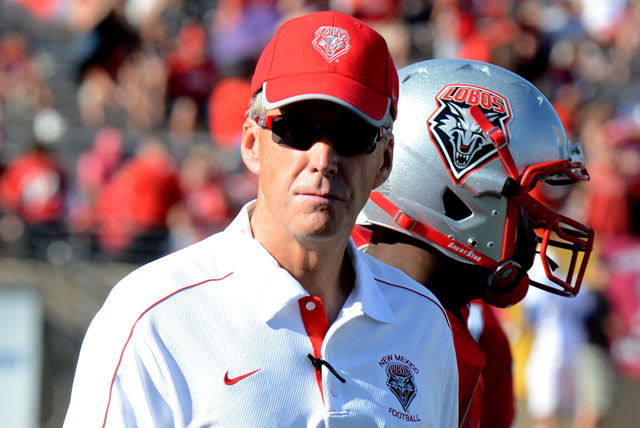Rebels, Lobos set to showcase remade attacks

Football coaches borrow and adapt — some would call it stealing — and offenses can change from year to year.
UNLV and New Mexico, who meet at 5 p.m. PDT Saturday in Albuquerque, N.M., have taken such a practice a step further and remade their attacks.
The change was especially pronounced for New Mexico and a long time in coming. When Bob Davie coached at Notre Dame from 1994 to 2001, the last five seasons as the head coach, he was impressed with the difficulties in facing the option-based military academies.
Then as a college football analyst for 10 years for ESPN/ABC, Davie knew if he returned to coaching, it probably would be at a school with a troubled history. And he knew he would adopt some of the offensive philosophies favored by such schools as Air Force, which runs the triple option, as a starting point.
Now in his second year coaching New Mexico, he oversees an offense that has had 151 running plays for 801 yards this season to 41 pass attempts for 229 yards.
“We really have to be that right now,” Davie said.
He hopes to morph into a pistol offense in the next year or two and open up the attack.
“As we get more explosive skill players, we’ll become more balanced,” Davie said. “I think that’s the decision going forward we have to make.”
So it will be an offense that continues to evolve, similar to what has taken place at UNLV.
When Bobby Hauck arrived at UNLV after the 2009 season, he switched the offense from previous coach Mike Sanford’s spread to a more traditional look. He kept that approach through his first three seasons before hiring Timm Rosenbach as offensive coordinator.
Rosenbach has brought in more of a spread look that includes a healthy dose of zone read, though the Rebels still maintain a power running game more closely associated with Hauck’s first three seasons.
“It’s a departure from last year, no question,” Davie said. “All of the sudden, with (quarterback Caleb) Herring in there, the zone read is a definite weapon. It seems to be that Herring really does fit the direction they seem to be going.”
Herring became the starter this season after Nick Sherry faltered early, throwing five interceptions through the first nine quarters.
Herring is much more mobile, allowing UNLV to be more effective with the zone read, which gives him the option to hand off to a running back or keep the ball.
“He’s a little faster than Nick, a little more athletic with the ball,” Hauck said. “Nick’s had some decent runs, but it’s probably a little bit bigger piece of (Herring’s) game than Nick’s.”
Herring was signed by Sanford to run the spread, and he never looked comfortable in the traditional offense two seasons ago. He completed 54.9 percent of his passes for 1,004 yards (100.4 yards-per-game average), with eight touchdowns and six interceptions.
Sherry then became the starter last season.
This season, Herring has completed 77.8 percent of his passes for 420 yards (406 in his past two games), with four touchdowns and no interceptions. He also has rushed for 57 yards.
Herring said running the zone read, which makes the defender react first, is “a big advantage. That’s kind of why it’s such a highly sought-after offense.
“It’s definitely a good feeling to know that you’re kind of in control of what the result of the play is.”
Rosenbach said the offense is flexible enough to play to the strengths of both quarterbacks, but the system clearly has been more successful with Herring.
“What you’re seeing is kind of the start of the offense,” Rosenbach said. “There’s a tremendous amount of versatility to the offense. You’ve got to play to the strengths of what you’ve got on the field.”
Contact reporter Mark Anderson at manderson@reviewjournal.com or 702-387-2914. Follow him on Twitter: @markanderson65.












